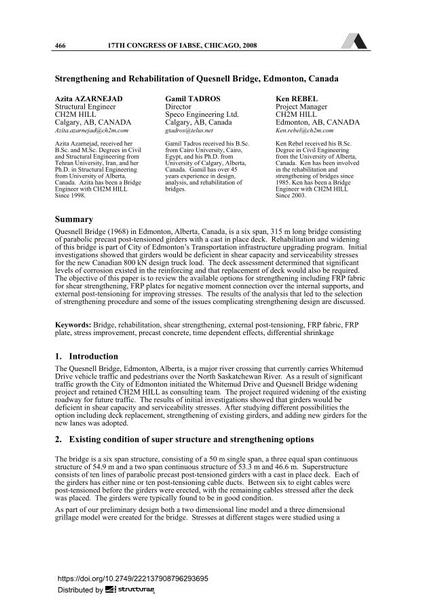Strengthening and Rehabilitation of Quesnell Bridge, Edmonton, Canada

|
|
|||||||||||
Bibliographic Details
| Author(s): |
Azita Azarnejad
Gamil Tadros Ken Rebel |
||||
|---|---|---|---|---|---|
| Medium: | conference paper | ||||
| Language(s): | English | ||||
| Conference: | 17th IABSE Congress: Creating and Renewing Urban Structures – Tall Buildings, Bridges and Infrastructure, Chicago, USA, 17-19 September 2008 | ||||
| Published in: | IABSE Congress Chicago 2008 | ||||
|
|||||
| Page(s): | 466-467 | ||||
| Total no. of pages: | 8 | ||||
| Year: | 2008 | ||||
| DOI: | 10.2749/222137908796293695 | ||||
| Abstract: |
Quesnell Bridge (1968) in Edmonton, Alberta, Canada, is a six span, 315 m long bridge consisting of parabolic precast post-tensioned girders with a cast in place deck. Rehabilitation and widening of this bridge is part of City of Edmonton’s Transportation infrastructure upgrading program. Initial investigations showed that girders would be deficient in shear capacity and serviceability stresses for the new Canadian 800 kN design truck load. The deck assessment determined that significant levels of corrosion existed in the reinforcing and that replacement of deck would also be required. The objective of this paper is to review the available options for strengthening including FRP fabric for shear strengthening, FRP plates for negative moment connection over the internal supports, and external post-tensioning for improving stresses. The results of the analysis that led to the selection of strengthening procedure and some of the issues complicating strengthening design are discussed. |
||||
| Keywords: |
bridge rehabilitation precast concrete Shear strengthening external post-tensioning FRP fabric FRP plate stress improvement time dependent effects differential shrinkage
|
||||
